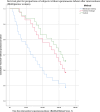Comparing membrane sweep and cervical massage in preventing the need for formal labour induction in uncomplicated pregnancy at term: Secondary analysis of a randomized controlled trial
- PMID: 40392830
- PMCID: PMC12091732
- DOI: 10.1371/journal.pone.0324172
Comparing membrane sweep and cervical massage in preventing the need for formal labour induction in uncomplicated pregnancy at term: Secondary analysis of a randomized controlled trial
Abstract
Introduction: Any intervention aimed at maximizing the spontaneous onset of labor and preventing formal induction will be beneficial to the client and welcomed by the provider, because it reduces postmaturity and formal labour induction.
Methods: We recruited and randomized 312 uncomplicated singleton pregnancies at 38 weeks of gestation into three groups: membrane sweep (MS), cervical massage (CM), and sham sweep (control). Each intervention was administered at 39 weeks and repeated at 40 weeks of gestation if spontaneous labor, defined as a Modified Bishop's Score of ≥7, did not occur. (Sri Lanka clinical trials registry - SLCTR/2020/003).
Results: The membrane sweep reduced the need for formal induction, whereas cervical massage did not. (MS vs C RR = 1.4195, 95% CI = 1.0326-1.9513, p = 0.0310; MS vs C OR=1.8739, 95% CI = 1.0664-3.2927, p = 0.0290; Number Needed to Treat = 7; CM vs C RR = 1.2043, 95% CI = 0.8598-1.6867, p = 0.2795). "Survival without spontaneous labor," was lower after the membrane sweep than in controls overall (MS vs C - p = 0.007; CM vs C - p = 0.261), among primiparous (MS vs C p = 0.047; CM vs C p = 0.269) and multiparous (MS vs C p = 0.038; CM vs C p = 0.456) women. The membrane sweep and cervical massage were safe concerning feto-maternal complications and both reduced hospital-stay duration among multiparous women (MS vs C p < 0.0001, 95% CI = 0.5293-1.1791; CM vs C p < 0.0001, 95% CI = 0.6816-1.3552). There was no increased risk of emergency cesarean delivery, oxytocin augmentation, uterine hyperstimulation, postpartum bleeding, maternal pyrexia, or Apgar score < 7 at 5 minutes (p > 0.05). The membrane sweep was less acceptable compared to cervical massage, regardless of parity (MS vs C Primi p = 0.001, Multi p = 0.0216).
Conclusion and recommendations: We recommend routine offer of membrane sweep to reduce the need for formal induction in term uncomplicated pregnancies, but clinicians should be aware of its inherent discomfort to women.
Copyright: © 2025 Madugalle et al. This is an open access article distributed under the terms of the Creative Commons Attribution License, which permits unrestricted use, distribution, and reproduction in any medium, provided the original author and source are credited.
Conflict of interest statement
The authors have declared that no competing interests exist.
Figures



Similar articles
-
Acupuncture or acupressure for induction of labour.Cochrane Database Syst Rev. 2017 Oct 17;10(10):CD002962. doi: 10.1002/14651858.CD002962.pub4. Cochrane Database Syst Rev. 2017. PMID: 29036756 Free PMC article.
-
Maternal and neonatal outcomes of elective induction of labor.Evid Rep Technol Assess (Full Rep). 2009 Mar;(176):1-257. Evid Rep Technol Assess (Full Rep). 2009. PMID: 19408970 Free PMC article.
-
Planned early birth versus expectant management (waiting) for prelabour rupture of membranes at term (37 weeks or more).Cochrane Database Syst Rev. 2017 Jan 4;1(1):CD005302. doi: 10.1002/14651858.CD005302.pub3. Cochrane Database Syst Rev. 2017. PMID: 28050900 Free PMC article.
-
Nitric oxide donors for cervical ripening and induction of labour.Cochrane Database Syst Rev. 2016 Dec 5;12(12):CD006901. doi: 10.1002/14651858.CD006901.pub3. Cochrane Database Syst Rev. 2016. PMID: 27918616 Free PMC article.
-
Fundal pressure during the second stage of labour.Cochrane Database Syst Rev. 2017 Mar 7;3(3):CD006067. doi: 10.1002/14651858.CD006067.pub3. Cochrane Database Syst Rev. 2017. PMID: 28267223 Free PMC article.
References
-
- Martin J, Hamilton B, Ventura S, Osterman M, Kirmeyer S, Mathews T, et al.. Births: final data for 2009. National vital statistics reports. 2011. - PubMed
Publication types
MeSH terms
LinkOut - more resources
Full Text Sources

